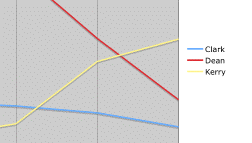|
Mark Frauenfelder blogged
today about the Iowa
Electronic Markets (IEM), a futures market run by the University
of Iowa for studying predictions of political elections and other
events. I love the idea of these markets and have been following them
closely. While the Policy
Analysis Market caught some well-deserved criticism last summer, I
didn't think it was a crazy idea, but that it was more poorly explained than
poorly conceived.
I was following the IEM during the Democratic Presidential primaries, and was disappointed with the results of what I saw. These markets are sometimes claimed to "predict the future," and rightly so in that they can expose upcoming events that are for whatever reason non-obvious by conventional wisdom. It was not obvious to me that Howard Dean would suffer such an upset in the Iowa Caucuses, placing behind Kerry and Edwards when all the polls were showing a different result. After the shoes had all fallen, I went back to the IEM to see if these futures markets -- based, after all, in Iowa -- had been able to predict what many of us had missed.
No one has claimed predictive markets are perfect, nor that they can forecast everything -- just that they tend to outperform other predictive measures. I'll be interested to see if this idea takes greater hold over time, and gains in effectiveness as it involves more participants. |
||

